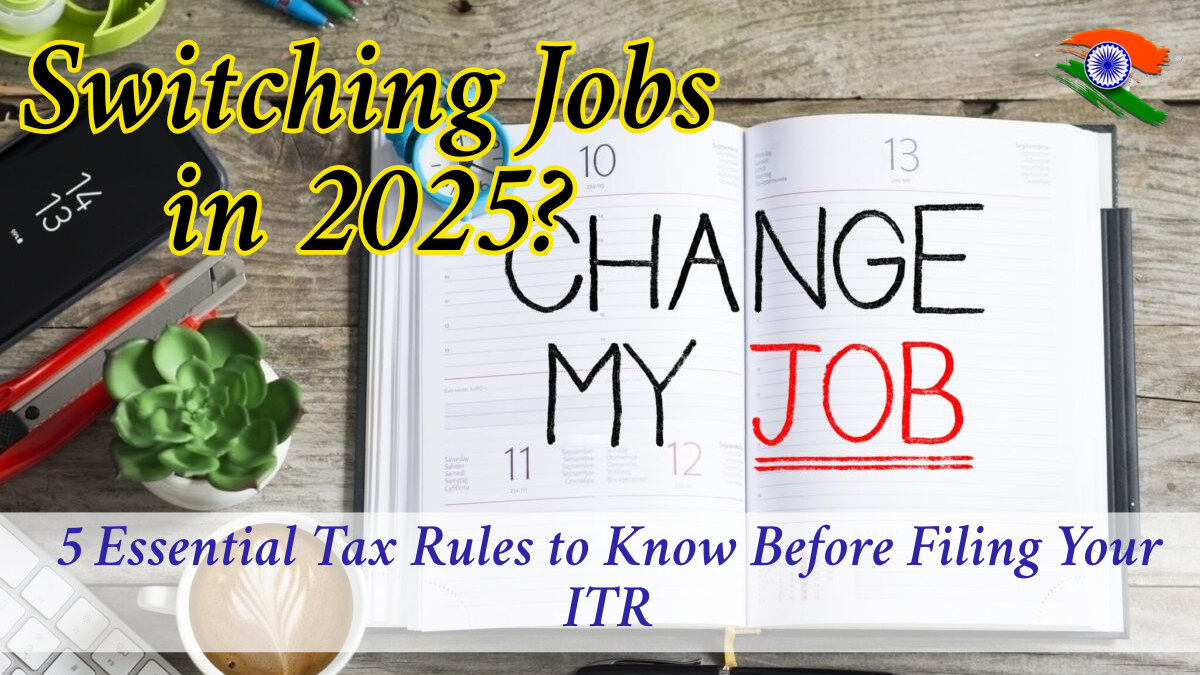In the evolving professional landscape, switching jobs has become increasingly common as professionals seek better salaries, improved work environments, and career growth opportunities. However, with each job change comes new tax responsibilities that must be carefully handled, especially while filing your Income Tax Return (ITR).

If you’ve already changed jobs during the financial year or plan to do so soon, it is crucial to understand how this can affect your income tax filing. Missteps can lead to inaccurate returns, unwanted tax notices, and even penalties.
This comprehensive guide covers 5 critical tax-related rules you must follow while changing jobs in the same financial year to ensure smooth and compliant ITR filing.
Table of Contents
Quick Summary Table: Switching Jobs in 2025
Aspect |
Details |
|---|---|
Purpose |
Understanding tax rules while switching jobs in the same financial year |
Key Concern |
Correct reporting of income and tax deductions |
Must Collect |
Form 16 from all employers |
Deduction Alert |
Avoid duplicate claims for same investments |
Special Income Consideration |
Gratuity, Leave Encashment – declare them properly |
Cross-check Requirement |
Verify Form 26AS for TDS reconciliation |
Salary Reporting |
Report salary from both old and new employers accurately |
Official ITR Filing Site |
1. Collect Form 16 From All Employers
One of the first and most important things to do after a job switch is to collect Form 16 from both the previous and current employers.
What is Form 16?
- It is a certificate issued by an employer to their employees.
- It contains details of the salary paid and TDS deducted during the financial year.
- It is divided into two parts:
- Part A: Contains details of TDS deducted and deposited with the government.
- Part B: Provides a detailed breakup of salary, exemptions, and deductions.
Why is it important?
- When you’ve had multiple employers in a single year, each would have deducted TDS based on the income paid by them.
- The Income Tax Department, however, assesses total income.
- Missing any Form 16 could lead to underreporting income, which may attract penalties or scrutiny.
Tip: If you did not receive Form 16 from your previous employer, request it via email or HR. If unavailable, you can use your salary slips and Form 26AS as alternatives.
2. Avoid Claiming the Same Deduction Twice
Taxpayers often make the mistake of claiming the same deductions multiple times due to job transitions.
Common duplications include:
- EPF (Employee Provident Fund)
- PPF (Public Provident Fund)
- Health Insurance Premium
- 80C Investments
- Home Loan Principal or Interest
Why does this happen?
- Your new employer may ask for fresh investment declarations.
- If you do not share previous declaration data, they may allow the same deductions again, leading to overstatement of deductions.
How to prevent it?
- Maintain a comprehensive list of your deductions throughout the year.
- When declaring investments with the new employer, include the ones already declared.
- At the time of filing your ITR, manually enter correct values and cross-check them with documentary proof.
3. Declare Gratuity and Leave Encashment Properly
If you have worked with your employer for more than 5 years, you may be eligible for gratuity when you resign. Similarly, leave encashment received upon resignation is also considered income.
Tax Treatment:
- Gratuity: Tax-free up to ₹20 lakh under Section 10(10).
- Leave Encashment: For non-government employees, exemption under Section 10(10AA) is limited to ₹3 lakh.
Key Point:
- Both gratuity and leave encashment are considered income, and you need to report them in your ITR, even if part or all of it is tax-exempt.
- Retain documentation from your employer for reference.
4. Verify Tax Details with Form 26AS
Form 26AS is an annual tax statement that summarizes all tax-related information such as:
- TDS (Tax Deducted at Source)
- TCS (Tax Collected at Source)
- Advance Tax Paid
- Refunds Received
- High-Value Transactions
Why is it important during job change?
- It helps verify whether all employers have correctly deposited TDS.
- Mismatches between Form 16 and Form 26AS can lead to issues during tax assessment.
Tip: Download Form 26AS from the income tax portal (https://www.incometax.gov.in) before filing your return and reconcile all income and TDS details.
5. Report Combined Income from All Employers
A common error among salaried taxpayers is reporting only the salary from the current employer, while ignoring the income earned from previous jobs in the same financial year.
Why does this matter?
- The tax department receives TDS data from all employers.
- Failing to report income from the earlier employer results in under-reporting, which may lead to:
- Notices under Section 143(1)
- Revised returns
- Penalty for misreporting income
Correct Approach:
- Add total salary earned from all employers during the year.
- Include bonuses, encashments, and any other payouts.
- Ensure that your ITR reflects your actual total income.
Other Considerations While Changing Jobs
Provident Fund (PF) Transfer
- Do not withdraw PF immediately after switching.
- Transfer it to the new employer via UAN (Universal Account Number) portal.
- Early withdrawal may be taxable if not in service for at least 5 continuous years.
ESOPs and Perquisites
- If your previous employer granted ESOPs or gave taxable perquisites, include these in your income disclosures.
Form 12B
- On joining a new job, submit Form 12B to your new employer.
- This helps consolidate income and deduction details for accurate TDS calculation.
FAQs: Tax Filing When Switching Jobs
1. Can I file ITR without Form 16?
Ans. Yes, if Form 16 is unavailable, you can use salary slips, Form 26AS, and bank statements to compute your income.
2. What if my old employer didn’t deduct enough TDS?
Ans. You will need to pay the remaining tax while filing your ITR. Interest may apply under Section 234B and 234C.
3. How do I check if TDS has been deposited by both employers?
Ans. Login to https://www.incometax.gov.in and download Form 26AS or AIS (Annual Information Statement) to verify TDS entries.
4. Is it mandatory to report gratuity and leave encashment?
Ans. Yes, even if they are tax-exempt up to a limit, they must be declared in the ITR.
5. What happens if I forget to report income from my old job?
Ans. This may trigger a compliance notice from the Income Tax Department. File a revised return if you’ve already submitted the original one.
Conclusion
Job switches are a positive step toward professional growth, but they come with added tax responsibilities. Failing to collect Form 16s, report full income, or reconcile TDS can lead to errors in your Income Tax Return.
By staying vigilant, understanding the tax implications, and preparing thoroughly, you can ensure smooth, error-free filing and avoid unnecessary complications later.
For more information or to file your ITR, visit the official tax portal:
https://www.incometax.gov.in




